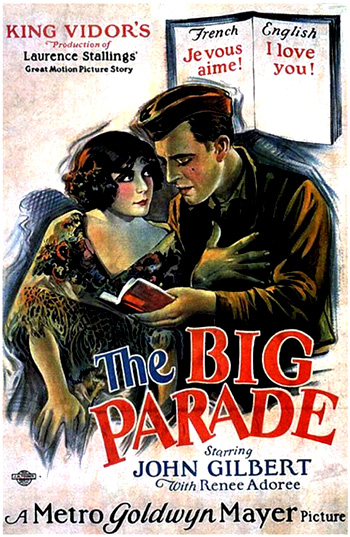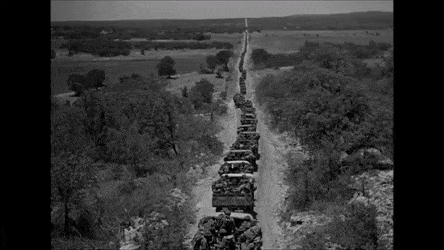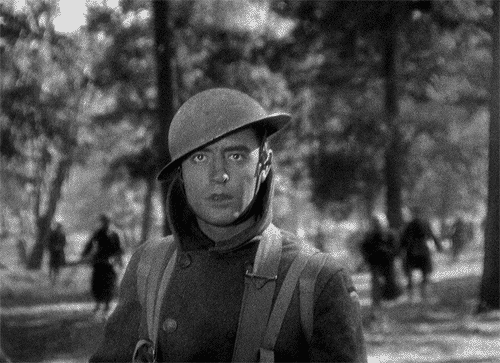O ano era 2011. O oitavo
episódio da quarta temporada de The Big Bang Theory, “The 21-Second
Excitation”, trazia nossos nerds favoritos, encabeçados pelo grande, poderoso e
incrível Sheldon, em uma ida ao cinema para ver a versão restaurada de “Os
Caçadores da Arca Perdida / Raiders of the Lost Ark”, com incríveis 21 segundos
de filmagem nunca vistos. Este era um dos poucos episódios de The Big Bang
Theory com o qual eu não havia me identificado. Até agora.
The year was 2011. The eighth episode of season four
of The Big Bang Theory,”The 21-Second Excitation”, brought our favorite nerds,
including the mighty Sheldon, in a trip to the movies to see the restored
version of “Raiders of the Lost Ark”, with amazing 21 seconds of
never-before-seen footage. This was one of the few The Big Bang Theory episodes
with which I had not feel an identification. Until
now.
É muito difícil escolher meu
filme mudo favorito, mas com certeza “O Grande Desfile / The Big Parade” (1925)
está entre os cinco primeiros. Fiquei loucamente emocionada quando o vi pela
primeira vez, em janeiro de 2014. Logo depois o escolhi para alguns prêmios
importantes em meu Oscar pessoal de 1925. E, quando descobri que a versão
restaurada do filme, com trinta minutos a mais de projeção, seria lançada em
DVD no Brasil, não tive dúvidas: comprei o box (que veio com outros cinco
filmes, mas o mais importante é “O Grande Desfile”).
It’s very hard for me to choose my favorite silent
movie, but for sure “The Big Parade” (1925) is among the TOP 5. I was crazily
moved the first time I saw it, on January 2014. Right after this, I chose it to
receive some important prizes on my personal 1925 Oscars. And, when I
discovered that the restored version of the film, with extra 30 minutes of
footage, was going to be on DVD in Brazil, I had no doubts: I bought the box
(that came with five other films, but the most important is “The Big Parade”).
O ano é 1917 e os Estados Unidos
acabam de entrar na Grande Guerra! O jovem herdeiro Jim (John Gilbert) se
alista no exército em um momento de loucura juvenil, e sua partida para lutar
na França coloca a mãe em desespero, deixa o pai muito orgulhoso e satisfaz a
vaidade da namorada de Jim, Justyn (Claire Adams). Ah, o que a música “Over
There” é capaz de fazer! George M. Cohan sabia das coisas! Mas a vida no
exército não é fácil! Apesar das dificuldades, Jim está feliz ao lado dos novos
amigos, Slim (Karl Dane), um operário, e Bull (Tom O'Brien), um barman.
Só a guerra poderia unir três pessoas tão diferentes.
The year is 1917 and the USA
just entered the Great War! Young
heir Jim (John Gilbert) joins the army in a moment of youthful craze, and his
departure to fight in France leaves his mother desperated, his father proud and
fullfils his girlfriend Justyn's (Claire Adams) vain wish. Oh, what can the
song “Over There” do! George M. Cohan knew a thing or two! But life at the army
isn't easy! Even though he faces difficulties, Jim is happy with his new
friends, Slim (Karl Dane), a construction worker, and Bull (Tom O'Brien), a
barman. Only the war could unite those three very different people.
E só a guerra faria Jim conhecer
uma linda garota francesa, Melisande (Renée Adorée), que vive em uma aldeia
perto do campo de treinamento de Jim. Apesar de não falarem a mesma língua,
eles se entendem com gestos singelos, como quando Jim ensina Melisande a mascar
chiclete. A cena é mais divertida que a dança de Gene Kelly quando ele percebe
estar apaixonado em “Cantando na Chuva / Singin' in the Rain” (1952) e ao mesmo
tempo com mais sensualidade e romance que a troca de cigarros acesos por Paul
Henreid em “A Estranha Passageira / Now, Voyager” (1942).
And only the war would make Jim
meet an adorable French girl, Melisande (Renée Adorée), who lives in a village
near Jim's training camp. Even though they don't speak the same language, they
understand each other with sweet gestures, like when Jim teaches Melisande how
to chew gum. The scene is more fun than the scene with Gene Kelly dancing when
he realizes he's in love in “Singin' in the Rain” (1952) and at the same time
is sexier and more romantic than the exchange of cigarettes in “Now, Voyager”
(1942).
Quais as diferenças entre a
versão já conhecida e a restaurada, que estreou no TCM Film Festival de 2013?
Poucas. Poucas mesmo. Primeiro, a versão restaurada tem as cenas noturnas em
tons de azul ou bege, enquanto na versão normal está tudo em preto e branco. As
imagens também são mais nítidas, perfeitas e praticamente em alta definição.
What are the differences between
the known version and the restored one, presented at the 2013 TCM Film Festival? A few. Very few. First, the
restored version has night scenes with tinting and toning, while in the normal
version everything is in black and white. The images are also clearer, perfect,
almost in high definition.
E é isso que ganhamos com os
trinta minutos extras de filme: mais imagens, e imagens mais nítidas. A versão
normal teve origem em uma cópia do filme com som sincronizado, feita em 1931,
enquanto a restaurada veio da versão original. Vale dizer que o filme é
projetado a uma velocidade menor, as imagens da versão restaurada passam mais
vagarosamente por nós que as da versão normal, talvez para que seja possível
prestarmos atenção em todos os detalhes. Há cenas inéditas reveladoras, como na
restauração de “Metropolis”? Não. Vivi milhões de dèja vú vendo a versão
restaurada, e a única cena da qual não me lembrava muito bem era da reunião /
sarau na casa de Melisande.
And this is what we get with the
extra thirty minutes: more images, and clearer images. The normal version was
originated in a copy with synchronized sound, made in 1931, while the restored
one came from the original version. We must say that the film is projected at a
slower speed, the images of the restored version go through us slower than in
the normal version, maybe so that we can pay attention to all details. Are
there new, vital scenes, like in the “Metropolis” restoration? No. I lived
millions of déja vú watching the restored version, and the only scene I didn't
remember was the one with the reunion at Melisande's house.
Por que este é um dos meus
filmes mudos prediletos? Junto com os outros filmes silenciosos que eu amo
loucamente (“A Caixa de Pandora”, “A Última Ordem / The Last Command”,
“Ben-Hur”, “Metropolis”...), “O Grande Desfile” é arrebatador. Foi arrebatador
em 1925, chegando a ficar dois anos em cartaz em um cinema, e permanece
arrebatador em 2015. Foi inovador ao não glorificar a guerra de modo algum, e
continua poderoso em suas cenas mais emocionantes (o autor da história foi
co-autor de “What Price Glory?” e, claro, veterano de guerra). John Gilbert,
Renée Adorée e Karl Dane não viveriam para ver a Segunda Guerra. John Gilbert
amou fazer este filme. Eu preciso concordar: ele nunca esteve mais belo, mais
tocante ou mais à vontade nas telas.
Why is this one of my favorite
silent films? With other silents that I love a lot (“Pandora's Box”, “The Last
Command”, “Ben-Hur”, “Metropolis”...), “The Big Parade” is ravishing. It was
ravishing in 1925, when it spent two whole years being shown in a movie
theater, and it is ravishing in 2015. It was innovative as it never glorified
the war, and it's still powerful in its most moving scenes (the author of the
story was the co-author of “What Price Glory?” and, of course, a war veteran).
John Gilbert, Renée Adorée and Karl Dane wouldn't live to the World War II.
John Gilbert loved doing this film. I have to agree: he never was so handsome,
touching or at ease in a film.
Há algo de belo na destruição
que a guerra traz e o filme mostra. Há algo de muito belo na trilha sonora
composta por Carl Davis em 1988. É um daqueles filmes que, quando acaba, eu
levanto e aplaudo, sem ter vergonha de ser vista, sem me importar com o fato de
que todos os envolvidos com a filmagem já estão mortos. É o tipo de filme que,
assim que acaba, quero voltar ao começo e ver de novo, e de novo, e de novo. É
o tipo de filme que eu compro em DVD com prazer, seja pelo realismo de suas
imagens, por 21 segundos ou por 30 minutos a mais da indelével magia do cinema.
There is something beautiful in
the destruction war brings and the film shows. There is something very beautiful
in the soundtrackcomposed by Carl Davis in 1988. This is one of those films
that, when it ends, I stand up and cheer, not ashamed of being seen, not caring
if all the ones involved in making the film are already dead. It's the kind of
film that, as soon as it ends, I want to go back to the beginning and watch
again, and again, and again. It's the kind of film whose DVD I buy with
pleasure, no matter if it is for the realism of its images, for 21 seconds or
for 30 extra minutes of the amazing film magic.
This post is part of the My Favorite Classic Movie
blogathon, in honor of the first National Classic Movie Day (May 16th). The
blogathon is hosted by Rick at Classic Film an TV Cafe.
Um livreto sobre o filme pode ser encontrado AQUI.
A booklet about the film can be found HERE.







11 comments:
I just went to see It with live music, and the composer said he'd be doing The Big Parade in July. You've just given me a reason to go:) Thank you.
ah, esse eu não vi. pensava em vc agora. acabei de postar um filme clássico. beijos, pedrita
Even into the 1930s "The Big Parade" would be re-released and sell out big theatres in major cities. Truly, a great film for all time.
I very much enjoyed your personal thoughts on the film.
Having not yet seen the restored version, it was fascinating to learn what was added and altered from the more-commonly shown BIG PARADE. Enjoyed your BIG BANG THEORY intro, too.
Beautiful review Leticia. I saw The Big Parade at the TCM Film Festival two years ago and it was magnificent. Both of my grandfathers were in WWI in the French army, so I grew up hearing about the war.This is also a great love story and that part of the story makes you weep and clap and the end.
A very beautiful and moving post, my dear. John Gilbert really proves he was a superior actor here and thank you so much for mentioning the Carl Davis score. This man has made silent come alive for many of us - his music is a vital part of the way silents should be seen (and heard).
Seu Blog sempre traz algo que eu não conhecia, obrigado! Pena que o TCM do Brasil é uma porcaria! E pensar que já foi um dos melhores canais a cabo, agora parece que só tem um número bem limitado de filmes, que não são dos melhores e os mais antigos só passam nas madrugadas e mesmo assim são Scaramouche, Ivanhoé, Os filhos de Katie Elder e mais uns dois ou três. Desculpe o desabafo, mas adoro filmes antigos e cada vez é mais difícil assisti-los. Bons tempos que a Globo tinha a Sessão "Classe A" e a extinta Manchete a sessão "Cinema de Primeira Classe".
Quanto aos filmes mudos, o meu preferido é A Paixão de Joana d'Arc, (The Passion of Joan of Arc, 1928), de Carl Theodor Dreyer, com a inigualável Renée Falconetti que tem a melhor atuação seja de uma atriz ou de um ator no cinema que eu já vi. Se não assistiu assista, não vai se arrepender.
Tudo de bom e parabéns pelo Blog!
Realmente é um belo filme. O Vidor é mestre. Mas nao consigo gostar de John Gilbert e Renée Adorée.
I love that you want to applaud at the conclusion of this film.
I'm ashamed to say I've never seen this film...but...get this: My husband, who couldn't care less about classic film, has SEEN this movie and LOVES IT! Go figure!
Not sure how this one had slipped under the radar - but it had! Loved reading your very personal review, I think your enthusiasm will be infectious!
Oi, Lê!
Ótimo texto, cheio de sensibilidade.
Como você, eu também amo apaixonadamente este filme, no qual está tudo no lugar: a química entre o par romântico, a reflexão crítica sobre a Guerra, o ritmo, o uso da música. Ele me interessa especialmente por este último aspecto. Li que a trilha recente baseou-se na composta para a exibição original da obra, na época do cinema silencioso, ainda. Com o advento do cinema falado, uma nova cópia dele foi distribuída aos cinemas, com inserção da banda sonora, à maneira do que se dá em "Show People" (outra obra-prima do Vidor). Aliás, a trilha musical de ambos dialoga abertamente.
Adoro essas cenas que você citou, sobretudo a da conquista "silenciosa" - acho-a uma defesa simbólica do cinema silencioso, que naquela altura dava os últimos suspiros, malgrado a excelência que ele havia atingido. Comovo-me de soluçar sempre que vejo a cena da bota, mistura perfeita de drama e comédia.
Fico muito feliz que o filme esteja circulando no Brasil - procurei pra comprá-lo via Amazon mas mudei de ideia, pois sairia muito caro. Qual a distribuidora? Onde você o encontrou? Fiz uma mini-busca na internet e não achei nada.
Bjinhos
Dani
Post a Comment